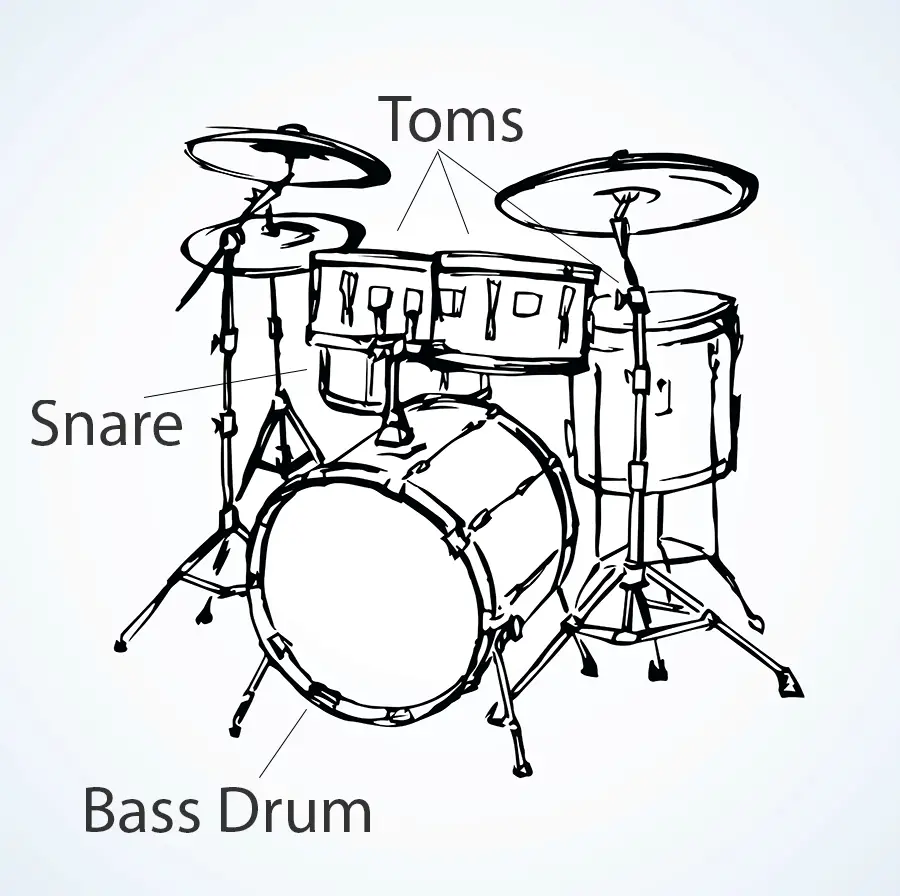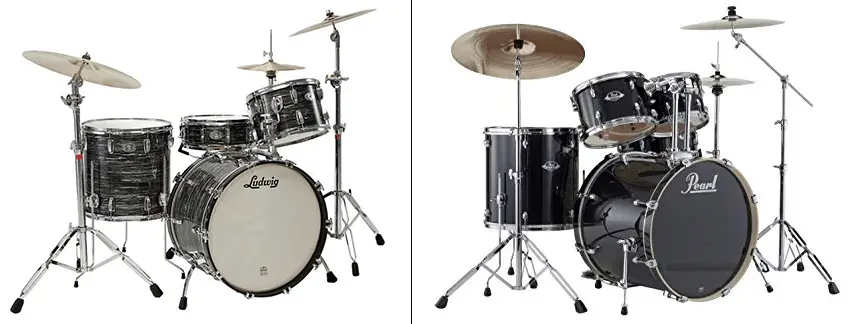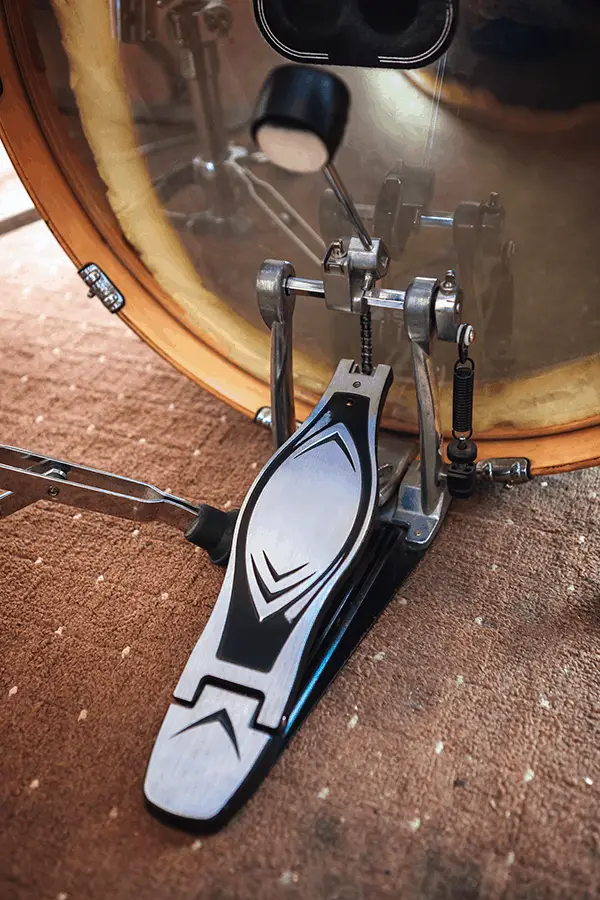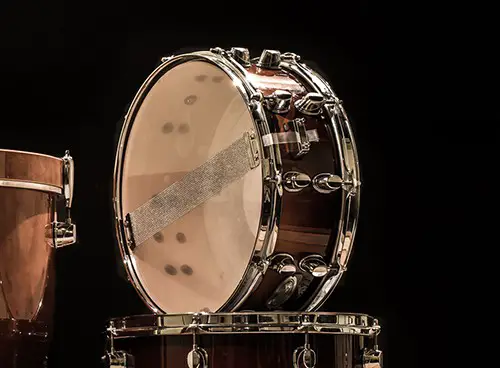
As a drum instructor, parents would often ask me to explain the basics of what the drums in a drum set were called so that they could not only speak with their child about the drums, but also be able to help set them up properly. What follows is some helpful detail into what each drum is called and what they are used for.
So, what are the drums in a drum set? The standard 5 piece drum set has one bass drum, one snare drum and three rack toms which are also commonly referred to as toms, hang toms or floor toms. A standard 4 piece configuration just removes one of the first two toms from the kit.
Now, that might have answered your fundamental question completely – or you’re left scratching your head even more so than before. Either way, let’s dig into some more details that will hopefully help you talk-the-talk.
The Standard 4 and 5 Piece Drum Sets
Let me start by saying that the layout and configuration of a drum set can get pretty creative and wild depending on who’s setting it up. That said, by far the most common versions of the drum set configuration are five piece and four piece drum sets – in that order.
For the sake of this article, I’ll focus on the five piece drum set, as it is by far the most common configuration for new drummers. The main difference between four and five piece kits is that one has two and the other has three toms. Pretty simple.

Right: Standard Five Piece Drum Kit
For more details on the difference between these and other common configurations, check out this article I wrote. For now, let’s focus on the components (and specifically the drums) of a drum set.
I wrote. For now, let’s focus on the components (and specifically the drums) of a drum set.
Top Tip:
Drum sizes are usually listed as two dimensions in inches, with the drum’s depth first and its diameter second. For example, a 9×12 tom specifies a 12″ diameter drum which is 9″ deep. This can be confusing to many first time buyers. Just remember to pay attention to the second number as depth isn’t nearly as important of a factor.
The Bass Drum
The bass drum (also commonly called the kick drum) is the foundation for any drum set. This is the drum which always lays on its side, with the bottom drum head facing forward. You know, the drum with your favorite band’s logo plastered all over it?

As the bass drum sits on its side, it cannot easily be struck with a drum stick like all other drums in the drum set can. Therefore, the use of a bass drum pedal is required. This means that the kick drum is played with the foot (typically the right foot in a right-handed configuration) and therefore necessitates the practicing and development of a whole different set of skills. Fun times!
Bass Drum Sizes:
While a 22″ diameter bass drum is by far the most common, other standard sizes for this drum include 20″, 24″ and sometimes 26″. Other size bass drums do exist, but you start to wander into “specialty drum set” territory.
Mounting Things To The Bass Drum
The bass drum can also serve as a mounting point for other drums and cymbals. This is the case with the majority of beginner 4 and 5 piece drum sets, where a metal bracket mounted to the top of the bass drum typically receives the mounting hardware (tom arms or cymbal arms) for the components which are placed right above the bass drum.
This configuration is not only efficient, but also cost effective as it removes the necessity for additional stands to suspend instruments from.
What About Those Chrome Bits on the Side?
Bass drums have a set of “legs” attached to their sides, which can be extended out to either side and provide the grip necessary to keep the bass drum upright and from sliding forward. These legs can also have spikes on them, depending on whether the drum is sitting on carpet or hard floor.
I wrote a separate article on how to keep your bass drum from sliding forward, which is a pretty common problem among drummers. Check it out here .
.
The Snare Drum
Ah yes, the snare drum. This is probably the most versatile and historic instrument in the modern drum set, as versions of it have been played for centuries. The snare drum has its origins in the military where it was used as a means to keep soldiers marching in time.

The modern snare drum is relatively similar in function but has enjoyed substantial technological evolution over the years.
In a drum set, the snare drum is most commonly mounted on a stand and positioned in between the drummer’s knees. Its positioning tends to be mostly horizontal, though is often found slanted slightly towards the player.
Snare Drum Sizes
Snare drums which come with a drum set are almost always 14″ in diameter and anywhere from 5″ to 6″ deep.
Those Wires On The Bottom Are Called Snares
The primary differentiating factor of a snare drum vs. other drums is the use of “snares” on the bottom drum head. Snares were traditionally made out of strings of animal gut and had a fairly muffled tone to them. Today, the majority of these snares are made out of metal wires attached to a frame.
The snares of a snare drum can be turned on and off via the use of a “throw off”, which is a little lever mounted on the side of the drum. Turning the snares on provides that familiar crack or buzzing sound associated with this drum. Turning the snares off eliminates this buzz and essentially creates a high pitched tom. This can be useful in creating different textures on the drum set and providing the drummer with an additional “voice” or tone with which to express themselves with.
All of that said, the primary purpose of a snare drum in a drum set is to provide that all too familiar, high pitched and punchy “backbeat” that is typically played on counts 2 and 4 of a measure in most styles of modern music.
The Snare Drum Is Like a Drummer’s Signature
If you’ve ever walked into a drum shop, you’ll likely have seen an entire section devoted only to the snare drum. There are several reasons why:
- Personal Preference is a big factor here. As a drummer’s skills develop, so will their taste in certain sounds
- Musical Styles can require different snare sounds
- Collecting snare drums is a favorite ‘hobby’ for most serious drummers
There are a ton of different variables which drum builders have incorporated into snare drum design, producing an infinite array of different instruments that all sound unique. These variables include different dimensions, building materials (wood, metal, acrylic), thick shells, thin shells, venting options…the list goes on and on.
The important thing to remember here though is that for the beginner especially, this really doesn’t matter. Don’t get overwhelmed by the choices. As a new drum student, I played on the same snare drum for nearly 5 years before getting into different drums.
The Toms
Toms are the drums suspended around the drummer, which are primarily used for drum fills but can occasionally be used for more repetitive ‘ride’ patterns as well. There are two primary types of toms:
- Hang/rack toms
- Floor toms
Hang toms (or rack toms) are typically hung from some sort of hardware, hence the name. This hardware can either be a mount which connects to the top of the bass drum, its own stand or a drum rack. These drums are usually the smaller size toms on the drum set, ranging from 8″ to 14″ in diameter.
Floor toms are the larger size drums of the kit. Because of their size, they are commonly free standing drums which are suspended on their own legs. Typical sizes for these drums are 16″ and 18″ diameter.
In a standard five piece configuration, you’ll usually encounter a 12″ and a 13″ hang tom, with a 16″ floor tom. As you can imagine, these sizes vary greatly from kit to kit, but it’s definitely not worth getting caught in the details here.
Related Questions
What is the top of a drum called? In order to be called a drum (and sound like one), the top of it has to have a drum head, sometimes referred to as a drum skin in reference to the animal hide that was used to make them. These days, drum heads are made of a plastic material which is stretched into a hoop.
How do drums make different pitches? The pitch of a drum is directly related to two factors: the size of the drum and how it is tuned. Typically, the smaller the drum, the higher in pitch it is. Similarly, the higher the tension on the drum head, the higher the pitch as well.
